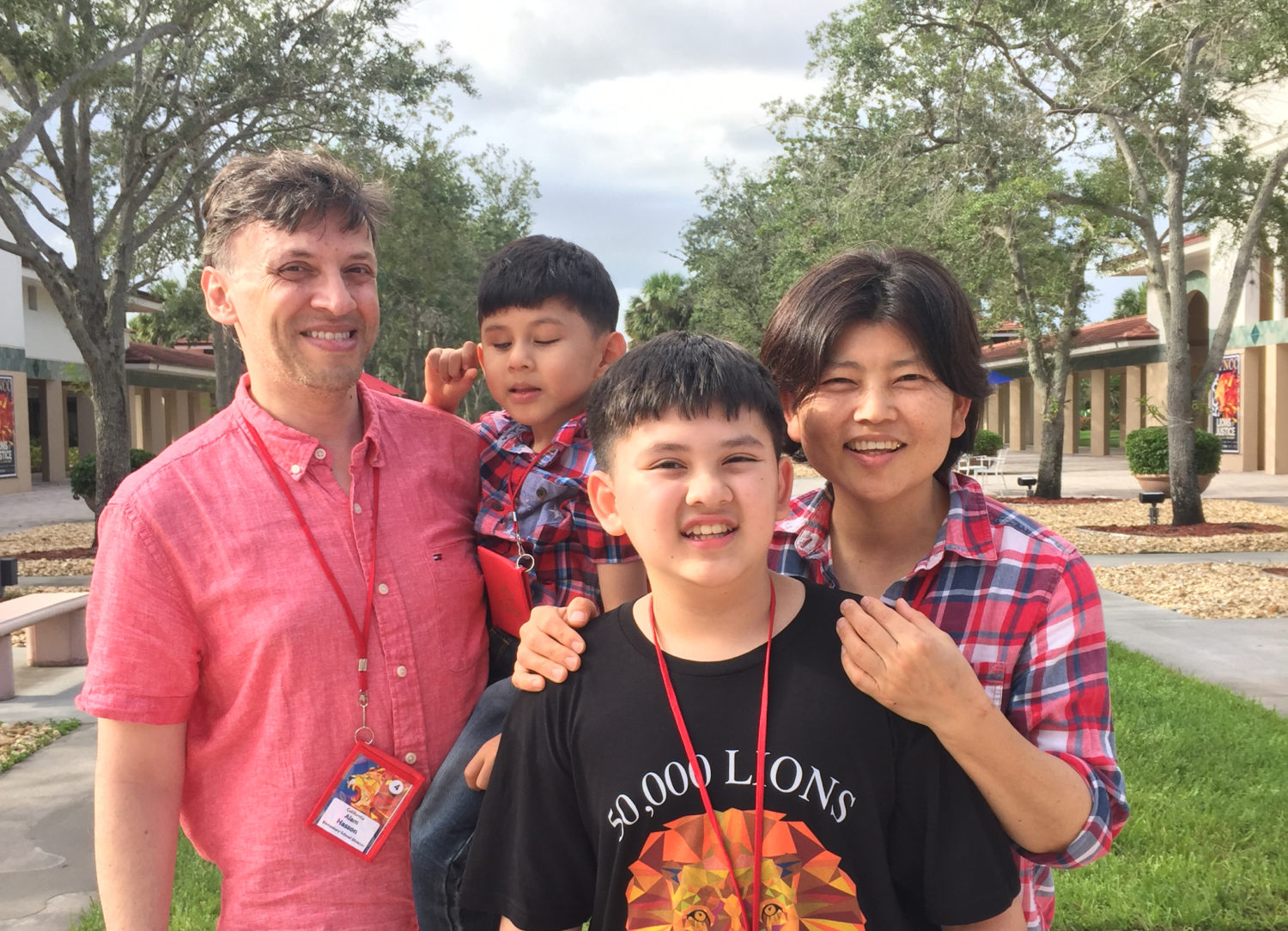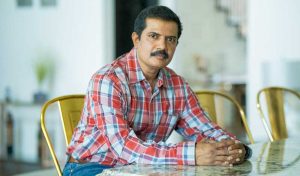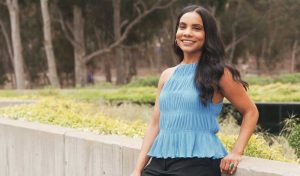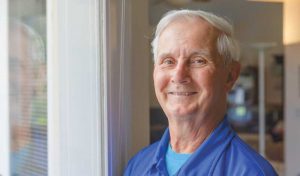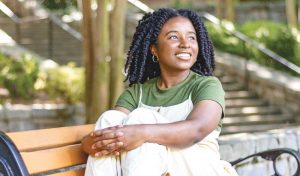by Myeong, Alam and Jason Hasson
Fresno, Calif.
World Tribune: Thank you for sharing your family experience with us, Myeong and Alam. We understand you faced a major obstacle as a family when your second child was born in 2012. Can you share what happened?
Myeong Hasson (wife): When Jason was born, he did not open his eyes for seven days and was diagnosed with persistent hyperplastic primary vitreous, meaning his eyes were not fully developed. We were told that, unless surgery could correct it, Jason would be blind.
I cried the whole ride home after our doctor’s appointment. Devastated and in disbelief, I wondered: I’ve been practicing Buddhism all these years. How could this be a benefit?
Alam Hasson (husband): When I first heard the news, I was filled with fear for Jason, especially thinking of a time when Myeong and I would no longer be around. I want my kids to be happy and successful, and not knowing what Jason’s future held made this a very difficult time for us.
WT: How did you use your Buddhist practice?
Myeong: I went straight to the Gohonzon and also read The Writings of Nichiren Daishonin. I was encouraged by these words: “Our worldly misdeeds and evil karma may have piled up as high as Mount Sumeru, but when we take faith in this sutra, they will vanish like frost or dew under the sun of the Lotus Sutra” (“Letter to Niike,” The Writings of Nichiren Daishonin, vol. 1, p. 1026). This was my opportunity to transform my karma by facing my challenges head-on and showing actual proof of the Mystic Law.
Alam: When I saw how confident Myeong was, I also determined to use the practice to ensure Jason’s victory. With our doctor’s suggestion, we pursued surgery.
WT: How did the operation go?
Myeong: In the two months leading up to the procedure, I chanted Nam-myoho-renge-kyo every day, throughout the day, with the determination that it would be successful and enable Jason to see. I did my best as a full-time mother and as a district women’s leader, caring for the members and helping people make a connection to Buddhism. Each time I talked to someone about the practice, I felt I was re-introducing myself to the power of the Mystic Law, and confidence and strength welled forth from within my life. My doubts began to subside.
Alam: We were told the surgery would take two hours. But on Feb. 5, 2013, 30 minutes after it began, the doctor informed us that he opted not to remove the scar tissue on Jason’s left eye because it was attached to his retina; taking it off could have caused more damage. The nurse also mentioned that when they gave him the anesthesia under his tongue, Jason was very resistant, and she suggested we see another doctor about that.
Myeong: However, when I heard this, I felt Jason knew, deep in his life, that the surgery would not work. That’s why he was resistant. Although we had been relying on this procedure for his victory, my Buddhist practice helped me realize that Jason chose this life, and he was carrying out his unique mission for kosen-rufu.
WT: How did things progress from there?
Myeong: We registered Jason as a blind child and signed him up for all the services he needed. When he was 1, he started chanting and doing gongyo every day. When we went out, people often looked at Jason with pity, but he was in fact the happiest person in our family.
Although I didn’t see Jason as a child with special needs, I worried about the difficulty he had learning to walk. I engraved these words from SGI President Ikeda in my heart and determined that Jason would be able to walk. Sensei says: “Transforming our karma doesn’t mean becoming a different person; it is establishing an inner state of supreme happiness, just as we are. Through awakening to our mission for kosenrufu, we realize that we are Bodhisattvas of the Earth. We also confirm that we possess the life condition of the Buddha, which guarantees that we can achieve absolute happiness. In other words, by realizing our mission for kosen-rufu, we are able to recognize the incredible happiness we possess inside” (The New Human Revolution, vol. 16, p. 76).
Alam: Jason helped me deepen my own confidence in the Gohonzon, and I became fully convinced he would walk. When he was 3, he started walking with the assistance of a walker. It is still a challenge; Jason has broken his legs four times. Despite this, he is becoming so strong and continues to recover. Each time Jason falls, he joyfully picks himself back up.
WT: How have things been more recently?
Myeong: In 2015, Alam and I took Jason and his older brother, Ethan, now 13, to the Hall of the Great Vow for Kosen-rufu in Tokyo. While there, I chanted with deep appreciation in front of the Gohonzon for Jason, for the happy life he leads and that we are able to do kosen-rufu together. We renewed our vow together and determined to share this amazing practice with others. Soon after, Jason introduced Buddhism to his school teacher and, in 2016, she received the Gohonzon! As a family, we have helped seven people receive the Gohonzon since then, and are continuing to tell many others about our practice.
WT: What have you learned from this experience?
Alam: We’re still learning and adapting to Jason’s unique needs. Everything takes longer and requires patience and planning. Because he experiences the world differently, he has lots of questions and needs verbal input and cues. Yet he wakes up at 5:30 a.m. every day, eats breakfast and goes straight to the Gohonzon to chant.
His big brother, Ethan, is always supporting him wholeheartedly. In fact, Ethan is working on a school science fair project, with the determination to build a detector to help Jason find things when he drops them.
Jason is truly the happiest person in our family, always laughing and bringing so much joy to those around him. Although he cannot see, he is showing me how to appreciate the many positive things in my life, rather than focusing on what I don’t have. For this reason, I am determined to continue doing my best, where I am, so that I can become a better colleague, husband and father than I was yesterday.
Myeong: Jason is now in first grade and celebrated his seventh birthday on Dec. 14. He is using his cane to walk and learning braille at school. He loves music and plays the piano, violin and drums! Jason is doing amazing.
It is just as President Ikeda assures, in The New Human Revolution, when responding to a grandmother who is deeply concerned about her blind grandson: “No child born into the practice is without a mission. If he awakens to his own unique mission, he will absolutely be able to lead the greatest of lives” (vol. 11, pp. 148–49).
WT: Jason, can you share how you’re doing in your own words?
Jason Hasson: I broke my left leg a few months ago, and I am still recovering. I really want to walk and play with my friends during recess. I chant Nam-myoho-renge-kyo with each step I take when I walk with my mom. My doctor recently said: “Your leg is healing very well. Please keep walking.”
Nam-myoho-renge-kyo works, and I love chanting every day! I want to keep sharing about Buddhism with my teachers and friends. WT
You are reading {{ meterCount }} of {{ meterMax }} free premium articles

